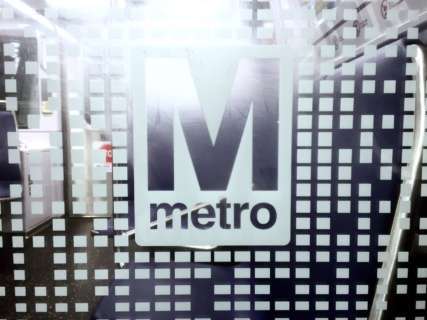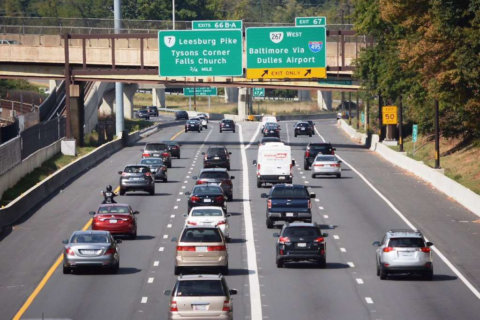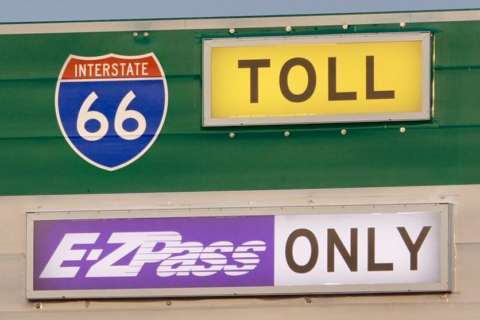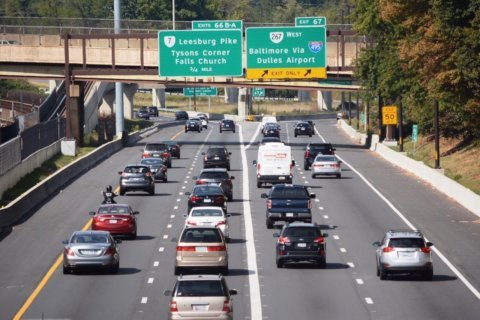WASHINGTON — Designs for two High Occupancy Vehicle or toll lanes in each direction on Interstate 66 between the Capital Beltway and Gainesville are still going through some significant changes, months after construction began.
Significant changes to designs include a taller, 4-foot concrete barrier separating the new bike path from the highway, and a potential overhaul of initial plans for the Nutley Street interchange near the Vienna Metro.
“We call it the ‘dog bone,'” Virginia Department of Transportation Megaprojects Director Susan Shaw said of the new design.
Instead of a diverging diamond interchange, where traffic goes through two traffic lights and crosses over to the ‘wrong’ side of the road, the new design would have two traffic circles on either side of the existing bridge that carries Nutley Street over Interstate 66 and the Metro tracks.
“A change that would really significantly change what we had previously talked about,” Shaw told the Vienna Town Council last week.
The redesign would make the interchange smaller than if the diverging diamond style were to be used, and would keep two existing ramps in place. It would also add an exit ramp from the westbound toll lanes to Nutley Street that would not have been built under the previous design.
The private companies building the lanes, Express Mobility Partners, had proposed a design like this in their bid as a cost-saving measure, but VDOT had some concerns that new designs attempt to address.
Shaw expected to have more details after Thanksgiving on the new design and its potential impact on traffic along I-66 and in the Nutley Street area.
“We do believe, though, based on what we’ve seen so far, it does … appear to improve traffic flow on Nutley Street compared with the diverging diamond,” she said.
It would also put a sidewalk — or shared-use path — through the area, either under or over the interchange to avoid the need to walk, jog or bike across a busy roadway.
Designers are also still working with Metro on designs for a new power station that must be relocated at the Dunn Loring Station. Public consideration of that project is expected in Fairfax County over the next six months.
Fairfax County Supervisor Linda Smyth told the Transportation Planning Board last week the county and VDOT continue to have discussions about I-66 designs and impacts.
A final noise and traffic study for the 22-mile corridor could be completed by the end of the year, Shaw said. They are also completing stormwater management plans, and analyzing where new or replacement sound walls are needed.
Current construction work is mostly focused on tree clearing, erosion control and utility relocations within land already owned by VDOT in the corridor. The state and EMP continue the eminent domain process to purchase all or parts of nearly 300 properties along the corridor. Seven relocation offers have been provided to those forced out of their homes.
On the road, drivers have already seen the “red x” lanes that otherwise functioned as shoulders erased as part of lane shifts to set up some work zones. More work zones are due to be set up soon, and lane closures are planned outside of rush hour.
New excavation is just getting underway for retaining walls near Jermantown Road, and excavation and blasting for storm drain trenches is starting up at what will become the University Boulevard Park and Ride Lot in Prince William County.
Current overnight work includes significant closures near Route 234 (Sudley Rd.), Fairfax County Parkway (Route 286), Route 50 in Fairfax, Route 123 (Chain Bridge Road), and part of Interstate 495 (Capital Beltway).
More work is scheduled to slow traffic next year.
“We really ask for your patience for these four years,” Express Mobility Partners CEO Javier Gutiérrez told a Northern Virginia Transportation Alliance breakfast this month.
“Design is progressing okay, construction started in April,” and completion of the toll lanes, which will be free for drivers with at least two other people in the car and an E-ZPass Flex switched to HOV mode, is on schedule for Dec. 2022, he said.








